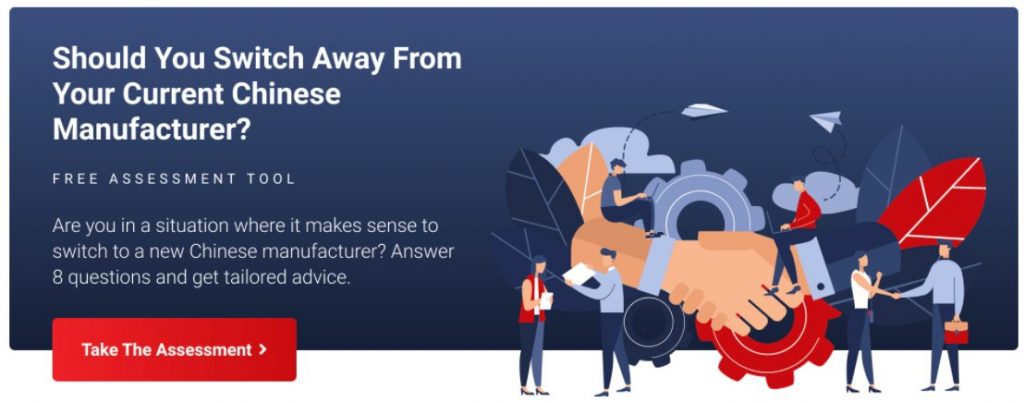There are cases where importers really need to leave a current supplier. Some situations are unlikely to improve over time, and they are even likely to get worse.
I wrote about this in 7 Reasons to Switch to a New Chinese Manufacturer last week. But the next logical question is, ‘How to transfer production from the current factory to the next?’ and that’s what I am covering here.
I will also cover the right timing to break the news to the current manufacturer. It is a very sensitive topic since it typically impacts the whole business relationship in a pretty dramatic way.
1. First, be clear about who owns the product
In business terms, and to simplify a bit, I would say you own the product if you came up with its design and you funded all its development. By contrast, if you picked a nice sample on the Canton Fair and re-sold it in your country, it is definitely the supplier’s product (you are just a ‘distributor’).
In legal terms, it is more complicated. Unless your supplier has signed a development agreement that says otherwise, there is a very real possibility that the supplier has a claim over ownership of part/all of the IP rights.
What are the implications?
- If you are distributing a product that you don’t own, should you ask another factory to make it? I know this has been done many, many times in China. But is it the right thing to do? And are you sure you are not exposing yourself to a lawsuit?
- Can you forbid your current supplier from selling the same product to other companies? If they believe it is their product, they won’t think your position is fair, and they will probably NOT want to lose business opportunities.
- If you request the product design files (CAD drawings in STEP format, schematics and GERBER files for the electronics, and so on) but you didn’t pay for them, the supplier is not likely to send anything to you for free.
2. What does your manufacturing contract with the current supplier say?
Look for certain clauses:
- Tooling list, ownership, and right to pull at short notice — very common if you (the buyer) have paid for the tooling.
- Termination under breach of the agreement — the criteria to fulfil should be clearly laid out, the buyer should be able to terminate the agreement in case they are not fulfilled, and the modalities of who does what should be defined.
- Termination without breach of the agreement — in case the buyer decides to terminate the agreement, again, the modalities should be clear.
- Manufacturer’s obligation to provide certain information with a certain amount of detail — in addition to the design files I mentioned in the previous point, try to get the bill of materials (including the suppliers’ contact information).
- Manufacturer’s obligation to provide training, or technical support, to their replacement for a reasonable fee — this is not very common, but you might be able to negotiate it if your business is very attractive.
I am no expert on this topic. Make sure to talk to a lawyer specializing in China business law.
In the remainder of this article, I will assume you do NOT have a manufacturing agreement that can be enforced on your supplier. An awful lot of importers are in this situation.
3. Have you been clear about your level of expectations and your lack of satisfaction?
You need to follow a fair process with your current supplier.
Giving a lot of work to a manufacturer without making your expectations clear, and then pulling out because they didn’t meet your (untold) expectations, is not fair. It is not good business practice. Chinese factory owners can react brutally in that case, and for a reason.
Make sure you are not in that situation. Spend time documenting and explaining your quality standard (be prepared to repeat things). Make sure managers are aware of the few things that are most important to you and be as specific as you can.
If you haven’t done that with your current supplier and the relationship has already turned sour, it is probably too late. Do it right next time!
4. Have you picked and onboarded a new manufacturer?
Let’s be clear, your current supplier will NOT help train their replacement. If the product is relatively complex, onboarding a new supplier will be a lot of work. So, don’t wait. Start now.
The process of selecting the new supplier can be a lot of work. Here are some resources to guide you:
- I distinguished between ODMs, OEMs, and CMs
- I drew a list of contract manufacturers
- I wrote a few questions to ask potential suppliers
What will make the onboarding easier? If you have followed the advice I wrote above, you will have these documents, and they will be quite helpful:
- Description of your requirements, and documentation of a quality standard
- The design files, hopefully in their latest versions
- A detailed bill of materials
Ideally, you can start slowly and let them gain experience with small orders. That’s possible if you can have 2 factories making your product (without the need to relocate expensive tooling), or if you have amassed many months of inventory.
5. The delicate process of transferring tooling
If you suddenly ask to pull the tooling, it is a sure sign that you are moving manufacturing somewhere else. (To prevent that, you could start giving them the habit of pulling the tooling every time before 2 production runs.)
Have you got a written acknowledgement from the manufacturer that you own the tooling? It won’t guarantee that things will go smoothly — maybe the precious molds are at one of their suppliers, and that company believes they own the molds — but it will help. And, if it is part of an enforceable contract, all the better.
Let’s say you get an agreement. When it comes to the process of the transfer itself, you may want to follow the 10 steps I outlined here.
6. Set up a plan with your new manufacturer
Do not leave things up to chance. Careful planning is a must.
I suggested a 45-point checklist in How To Plan for Transferring Production To a New Factory.
Also, use your new supplier’s experience, and listen to their suggestions. They have probably done this before, and they have an idea of what is most important.
Your new supplier might have special requests. For example, if you are leaving your current supplier in bad terms, they might not want to be in direct contact with them, for fear of retaliation of some sort. A third party can help manage the transition.
7. When to tell the current supplier?
There is no right or wrong answer here. It depends.
- A small minority of buyers set rules and follow them. They might say, for example, “We have a backup supplier. We give you 6 months to build an effective quality system, and we will not accept any price increase. We can help you with guidance and engineering if you need. Anyway, after 6 months, if we see no marked improvements, we will cut the order quantity by 20 % each month.”
- Most buyers are not in a position to challenge their supplier this way. They make it clear that they are not satisfied, but they don’t say anything that can be understood as a threat, for fear of being threatened in turn. Then, they cut ties when they feel the timing is right.
Would your supplier expect to be notified long in advance?
Probably not. Most likely, they drop their own suppliers at a moment’s notice. So, don’t feel you have an obligation to do that (except if you signed an agreement that provides for a way to terminate the relationship, of course).
There is one thing for sure, though. Do not tell them face to face that you won’t order again if you owe them money. They might hold you hostage in China until you pay them in full!
*****
Transition periods are often stressful. Most importers who have prepared it well think to themselves ‘I wish I had done it sooner’. What are your thoughts?
Disclaimer
We are not lawyers. What we wrote above is based only on our understanding of legal requirements. QualityInspection.org does not present this information as a basis for you to make decisions, and we do not accept any liability if you do so.
Are you dissatisfied with your current Chinese supplier?
I know it’s a big decision to switch to a new supplier, so to make it easier I’ve created an assessment over at our Contract Manufacturing subsidiary, Agilian Technology, where you answer a series of 8 simple questions about your relationship and results from your current supplier and will be provided with a tailored response from us about if you truly should consider switching supplier right now.
It’s free and there’s no download required. Hit the image below to take the assessment:


